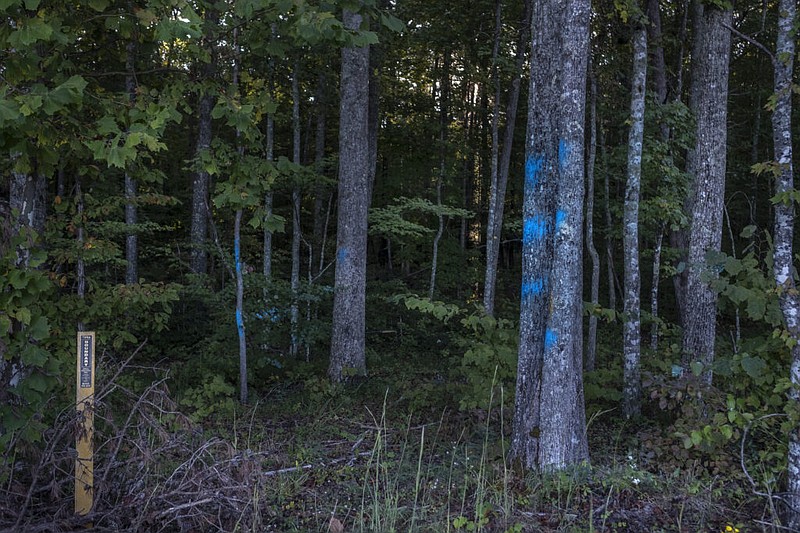A plan by the Tennessee Wildlife Resources Agency officials to clearcut forest in a popular hunting, hiking and recreation area in order to create habitat for Northern bobwhite quail has been given the legal go-ahead, despite opposition from residents and local leaders in White County, a bipartisan group of lawmakers and environmental groups.
The 16,000-acre Bridgestone Firestone Centennial Wilderness Area, a forested area adjacent to Fall Creek Falls State Park and Virgin Falls State Natural Area, was a late 1990s gift to the state from the tire company that came with certain strings attached, including that state officials "preserve the property predominantly in its present condition as a wilderness area."
The Tennessee Wildlife Federation was charged with ensuring the state honors those conditions.
On Friday, a spokeswoman for the Tennessee Wildlife Federation confirmed that outside legal counsel hired to review the state's clearcutting plan found it "meets the requirements" of the gift.
(READ MORE: Tennessee plans to turn old-growth forest into quail savanna ruffle feathers)
"Speaking broadly as a conservation nonprofit, we have supported throughout our 75-year history the science-based, proactive management of lands to maintain or restore diverse habitats and diverse wildlife," Kate Hill, a federation spokesperson, said via email. "The fact is, savannas are an endangered habitat in the Southeast that were once common and provided essential habitat to many species across Tennessee."
Neither the federation nor the state wildlife agency has communicated the outcome of the legal review to local residents, who have complained for months that they have been kept in the dark and offered no meaningful opportunity to weigh in on plans to radically alter a landscape that is both beloved and central to the local economy.
Vacation rentals, coffee shops, kayak and canoe rentals, a popular brewery and other small businesses in Sparta and surrounding communities cater to park-goers, hunters and - since the pandemic began - an increasing number of remote workers drawn by stunning vistas and small-town charm.
"This makes me want to double down," said Marvin Bullock, president of the chamber of commerce in Sparta and White County, east of Nashville, when he learned from a reporter that plans to clearcut potentially thousands of acres of hardwood forest to make way for grassy savannas had been approved.
(READ MORE: Lawmakers weigh in to oppose Tennessee Wildlife Resources Agency clearcutting)
"Our community was told it would basically be preserved forever," he said. "I would never have dreamed TWRA would say, 'let's cut these trees and create an artificial savanna.' When were they going to tell us? We never would have known about any of this if it weren't for the leaked map."
Late last summer, a map surfaced from the Tennessee Wildlife Resources Agency showing 2,000 acres of hardwood trees in the Bridgestone Firestone Centennial Wilderness Area were marked for removal as part of a long-term strategic plan to restore Northern bobwhite quail to Tennessee. The bird's population has plummeted in recent years, and the state agency wants to create a series of grassy savannas across the state to lure the birds back - and to lure game hunters, too.
The map sparked outrage among residents, community leaders and local deer and turkey hunters, who had noticed at the start of hunting season that blue spray paint marked cut lines on trees along the main road into the wilderness area, but did not know why.
Local leaders pointed out that the 16,000-acre wilderness reserve also contains hundreds of acres of pine trees, a fast-growing tree that is not native to the area. They asked why TWRA was not cutting those trees instead.
In response, TWRA officials held a community meeting in October. Some retired residents spoke of growing up playing and hunting in the woods. Quail hunters with the game bird advocacy organization, Quails Forever, spoke in favor of the efforts to create quail habitat. And TWRA officials tried to set the record straight in front of a room full of hundreds of local residents gathered on a weeknight at the local civic center. There had been a misunderstanding, they said. The map that was inadvertently leaked hadn't been vetted properly. They circulated a new map showing plans to cut 230 acres of hardwood forest in the "first phase" of establishing quail habitat in the wilderness area.
(READ MORE: TWRA officials face pushback over plans to raze old-growth forests in White County)
It remains unclear what the totality of TWRA's plans mean for the area. A five-year strategic plan published by the agency identifies the Bridgestone property as a "quail focal area." The document notes that a minimum of 1,500 cleared acres is necessary in a quail focal area.
Aubrey Deck, a regional coordinator for TWRA, said in an email on Friday he was "not familiar with any formal results or input from TWF at this time." He referred questions to the Tennessee Wildlife Federation, which did not respond to a request for a copy of legal review of clearcutting plans.
A spokeswoman for Bridgestone Americas, which retains the authority to intervene should state officials misuse their gift, said company officials had been notified of the outcome of the legal review.
"We understand the TWF and its outside counsel have conducted a comprehensive and detailed examination of a proposal brought forward by the Tennessee Wildlife Resources Agency (TWRA) and TWF has deemed that the proposal meets all environmental and land use covenants," Sara Stanton, the spokeswoman, said via email. "In its analysis, TWF provided TWRA with additional recommendations outside of the land use covenants that Bridgestone supports. We greatly appreciate the interest and concerns brought forward regarding this land and its use expressed by all parties. We will continue to rely on our partner nonprofits to uphold the covenants for all 16,000 acres we've donated to the state."
It is unknown what the additional recommendations are. Stanton referred questions to the Tennessee Wildlife Federation, which did not respond to a request to explain them.
